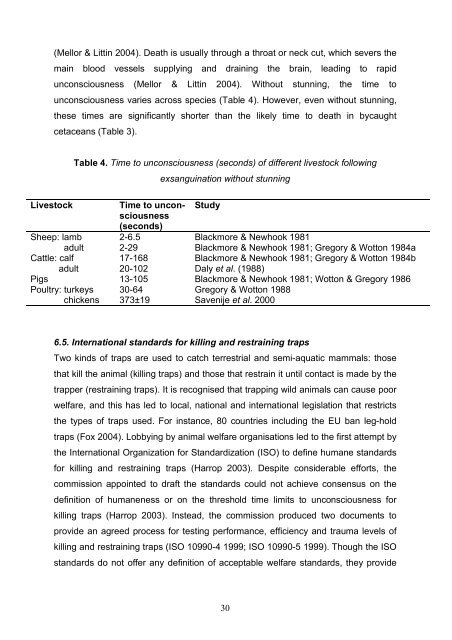The Animal Welfare Implications of Cetacean Deaths in Fisheries
The Animal Welfare Implications of Cetacean Deaths in Fisheries
The Animal Welfare Implications of Cetacean Deaths in Fisheries
Create successful ePaper yourself
Turn your PDF publications into a flip-book with our unique Google optimized e-Paper software.
(Mellor & Litt<strong>in</strong> 2004). Death is usually through a throat or neck cut, which severs the<br />
ma<strong>in</strong> blood vessels supply<strong>in</strong>g and dra<strong>in</strong><strong>in</strong>g the bra<strong>in</strong>, lead<strong>in</strong>g to rapid<br />
unconsciousness (Mellor & Litt<strong>in</strong> 2004). Without stunn<strong>in</strong>g, the time to<br />
unconsciousness varies across species (Table 4). However, even without stunn<strong>in</strong>g,<br />
these times are significantly shorter than the likely time to death <strong>in</strong> bycaught<br />
cetaceans (Table 3).<br />
Table 4. Time to unconsciousness (seconds) <strong>of</strong> different livestock follow<strong>in</strong>g<br />
exsangu<strong>in</strong>ation without stunn<strong>in</strong>g<br />
Livestock<br />
Time to unconsciousness<br />
Study<br />
(seconds)<br />
Sheep: lamb<br />
adult<br />
2-6.5<br />
2-29<br />
Blackmore & Newhook 1981<br />
Blackmore & Newhook 1981; Gregory & Wotton 1984a<br />
Cattle: calf<br />
adult<br />
17-168<br />
20-102<br />
Blackmore & Newhook 1981; Gregory & Wotton 1984b<br />
Daly et al. (1988)<br />
Pigs 13-105 Blackmore & Newhook 1981; Wotton & Gregory 1986<br />
Poultry: turkeys<br />
chickens<br />
30-64<br />
373±19<br />
Gregory & Wotton 1988<br />
Savenije et al. 2000<br />
6.5. International standards for kill<strong>in</strong>g and restra<strong>in</strong><strong>in</strong>g traps<br />
Two k<strong>in</strong>ds <strong>of</strong> traps are used to catch terrestrial and semi-aquatic mammals: those<br />
that kill the animal (kill<strong>in</strong>g traps) and those that restra<strong>in</strong> it until contact is made by the<br />
trapper (restra<strong>in</strong><strong>in</strong>g traps). It is recognised that trapp<strong>in</strong>g wild animals can cause poor<br />
welfare, and this has led to local, national and <strong>in</strong>ternational legislation that restricts<br />
the types <strong>of</strong> traps used. For <strong>in</strong>stance, 80 countries <strong>in</strong>clud<strong>in</strong>g the EU ban leg-hold<br />
traps (Fox 2004). Lobby<strong>in</strong>g by animal welfare organisations led to the first attempt by<br />
the International Organization for Standardization (ISO) to def<strong>in</strong>e humane standards<br />
for kill<strong>in</strong>g and restra<strong>in</strong><strong>in</strong>g traps (Harrop 2003). Despite considerable efforts, the<br />
commission appo<strong>in</strong>ted to draft the standards could not achieve consensus on the<br />
def<strong>in</strong>ition <strong>of</strong> humaneness or on the threshold time limits to unconsciousness for<br />
kill<strong>in</strong>g traps (Harrop 2003). Instead, the commission produced two documents to<br />
provide an agreed process for test<strong>in</strong>g performance, efficiency and trauma levels <strong>of</strong><br />
kill<strong>in</strong>g and restra<strong>in</strong><strong>in</strong>g traps (ISO 10990-4 1999; ISO 10990-5 1999). Though the ISO<br />
standards do not <strong>of</strong>fer any def<strong>in</strong>ition <strong>of</strong> acceptable welfare standards, they provide<br />
30
















